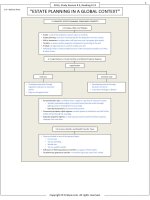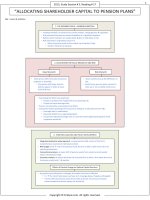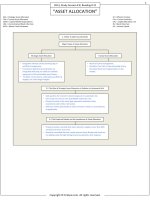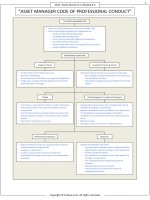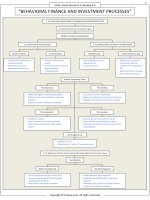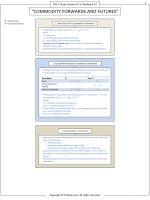FinQuiz smart summary, study session 12, reading 30
Bạn đang xem bản rút gọn của tài liệu. Xem và tải ngay bản đầy đủ của tài liệu tại đây (529.5 KB, 5 trang )
2013, Study Session # 12, Reading # 30
“EMERGING MARKETS FINANCE”
1. INTRODUCTION
Due to specific circumstances of EM, standard models are often not suitable to
apply.
Market integrations⇒ similar return for identical risk assets irrespective of their
domicile.
Liberalization should bring market integration with the global capital market & its
effects are:
Prices of local stocks.
Cost of equity.
Investments & economic welfare.
Integration process may have adverse effects:
Expected return & correlation b/w & EM & world market returns.
Diversification benefits.
Due to home bias, no full integration even among developed markets.
2. MARKET INTEGRATION AND LIBERALIZATION
2.1 The Theory of Market Integration
Domestic financial liberalization ⇒ banking sector reforms or even privatization.
Financial liberalization ⇒ freely movement (inflows & outflows) of foreign equity
investment.
Liberalization process is extremely complex (no established economic model).
When govt announces a liberalization, prices will & size of related to:
Credibility of the govt’s announcement.
Diversification benefits.
Market prices can change as investor anticipates liberalization may occur in the future
or upon announcement of liberalization.
Foreign investors may not enjoy “return to integration” (authorities may not allow
foreign ownership immediately).
Liberalization may liquidity, cost of capital, market concentration (more IPOs).
Liberalization process is macro focus & coincide with other economic policies (e.g.
inflation, exchange rate etc).
2.2 Measuring Market Integration
Liberalization process is complex & degree of market integration is very difficult to
measure.
Indirect ways to access local equity markets (e.g. ADRs) or investment restrictions
may not be binding.
The following risks (barriers) are diversifiable & not priced.
Kinds of Barriers
Legal Barriers
Arising from different legal
status of foreign & domestic
investors.
Indirect Barriers
Emerging Market Specific Risks
Due to difference in available
information, accounting
standards & investor protection.
These include liquidity, political,
currency & economic policy risk.
Copyright © FinQuiz.com. All rights reserved.
1
2
2013, Study Session # 12, Reading # 30
3. FINANCIAL EFFECTS OF MARKET INTEGRATION
3.1 Liberalization and Returns
Dividend yield is a better measure of cost of capital than returns (returns are highly
volatile).
Pre-liberalization, returns are upwardly biased (return to integration) & after
financial liberalization.
Volatility:
Post liberalization⇒ markets may become more informationally efficient,
volatility.
Pre-liberalization ⇒ may be swings from fundamental values, volatility.
In the long run, post-liberalization volatility .
Correlation & β with the world market after equity market liberalization.
ADRs from a country with investment restrictions is considered as liberalization.
3.2 Liberalization and Capital Flows
+ve relation b/w past returns & capital flows & in capital flows raises stock
market prices (no agreement whether effect is short term or long term).
Net capital flows to EM rapidly after liberalization as investors rebalance their
portfolios.
Dividend yield, cost of capital.
Volatility of capital flows around the time of market liberalization.
3.3 Liberalization and Political Risk
With equity market liberalization, the country ratings significantly
Political risk is a priced risk in EM (lower cost of capital).
(lower risk).
3.4 Liberalization and Diversification Benefits
EM equity returns are less correlated with equity returns in the developed world
(diversification benefits).
Liberalization may correlation & hence diversification benefits (by removing
price segmentation).
3.5 How Well Have Emerging Market Portfolios Done
Investments in EM are subject to herding & other irrational behavior.
Empirical studies shows that the overall investment performance of U.S. investors is
much rosier than country by country results, which focus on behavioral biases.
Copyright © FinQuiz.com. All rights reserved.
3
2013, Study Session # 12, Reading # 30
4. REAL EFFECTS OF FINANCIAL MARKET INTEGRATION
4.1 Why Would Financial Liberalization Affect Economic Growth
Financial liberalization may affect growth through no. of ways:
Equity prices, cost of capital, investments,
investment to GDP ratio, economic growth.
Better corporate governance, investments, growth.
4.2 Measuring the Liberalization Effect on Economic Growth
Liberalization effect measures the difference in growth before
& after liberalization & b/w segmented & financially open
countries.
4.3 Intensity and Simultaneity Problems in Measuring Real Liberalization Effects
4.3.1 Intensity of the Reforms
4.3.2 Financial Liberalization and Macroeconomic Reforms
Weak link b/w capital a/c openness & economic growth.
Liberalization has strong +VE growth effect.
Macro-oriented reforms can be the source of
liberalization effect always remain intact.
4.3.3 Financial Liberalization and Financial Market Development
4.3.4 Functional Capital Markets
It is possible that the liberalization may be the outcome of
financial development process.
Capital market imperfections ⇒ diff. b/w cost of internal &
external capital ⇒ foreigners may demand better corporate
governance ⇒ lead to cost of capital.
4.4 Other Real Effects of Financial Liberalization
Capital Inflows
Macroeconomic stance
Banking sector
Macroeconomic stance
Macroeconomic
vulnerability increases
Asset prices and real
exchange rate
appreciates
growth but the
Lending boom
Bank portfolios become
riskier
Post liberalization volatility in financial markets, also
Consumption growth volatility after liberalization.
Booms in consumption
and real estate
real variability.
Copyright © FinQuiz.com. All rights reserved.
2013, Study Session # 12, Reading # 30
5. CONTAGION
5.1 Currency Crises and Contagion
Literature on contagion has two components:
Why crises occur
Why crises spread
5.1.1 Predictable Currency Crises
Speculative pressures in currency may lead to a crisis &
devaluation. Two explanation:
Govt polices are not consistent with the currency peg
(expansionary fiscal & monetary policies, budget deficit
money growth, wages & prices lead to speculative
attack).
A significant group of investors starts speculating against
the currency that results in a large capital outflow &
currency collapse (currency crisis is unpredictable).
Marco-economic variables have predictability power to forecast
currency crisis.
5.1.2 Currency Crisis Contagion
When speculators attack one currency successfully, they may try another.
Contagion may be truly rational & perhaps, predictable.
Five channels of contagion:
Income effect of contagion ⇒ growth & income levels after a crisis, demand from other
countries.
Other countries may experienced similar -ve macro economic conditions or inconsistent policies.
Credit crunch (affected banks reduced lending in other countries) & forced-portfolio
decompositions (investors that face crisis in one country sell assets in other countries) are other
channels by which crisis spread.
Devaluation of one currency may cause devaluation of another currency.
Regional contagion ⇒ a currency is likely to devalue if a neighboring country has experienced a
currency devaluation.
5.2 Contagion and Equity Markets
Contagion in equity markets ⇒ markets move more closely
together during periods of crisis.
Correlation during a crisis period is due to volatility (no
contagion). Contagion is excess correlation over & above from
economic fundamentals forecast.
Contagion can also be linked to liquidity & financial frictions.
Copyright © FinQuiz.com. All rights reserved.
4
2013, Study Session # 12, Reading # 30
6. OTHER IMPORTANT ISSUES
6.1 Corporate Finance
Cross-section variation in legal institutions in EM affects the returns on equity.
Sufficient amount of debt in EM, the agency problem & multilevel ownership
agency problems.
Inadequate corporate governance ⇒ cost of equity capital in EM.
If management group’s control rights > its CF rights ⇒ firm value will .
During crisis controlling shareholders expropriate minority investors.
EM firms with cross-listed securities (e.g. ADRs) ⇒ better external governance &
shareholder value.
6.2 Fixed Income
Empirically, more research in EM equities than emerging market debt (availability
of more equity data).
EM bonds are risky, often behave like equity so correlation b/w EM bonds & EM
equities.
One study suggests that bond ratings are negatively related to population &
sovereign spread.
6.3 Market Microstructure
Market microstructure is related to functioning of secondary stock market.
Two key functions of secondary market:
Prices discovery ⇒ no investor can manipulate prices in her favor.
Liquidity ⇒ low transaction costs.
Due to cross-sectional heterogeneity of EM, considerable microstructure research
is required.
Due to lack of accurate & detailed data, genuine EM microstructure research is
very little.
Poor liquidity in EM may prevent foreign institutional investors not to invest in EM.
illiquidity ⇒ expected return.
6.4 Stock Selection
Information asymmetry problem in EM ⇒ stocks selection is
complex.
6.5 Privatization
Privatization ⇒ to productivity of state-owned economic enterprises & govt
budget deficit.
Privatization diversification & may affect the cost of capital in EM.
Privatization programs signal free market policies, sovereign risk premium &
cost of local market debt financing.
7. CONCLUSION
Copyright © FinQuiz.com. All rights reserved.
5



